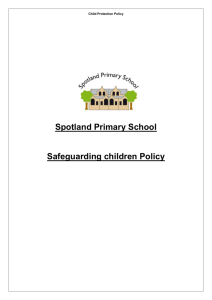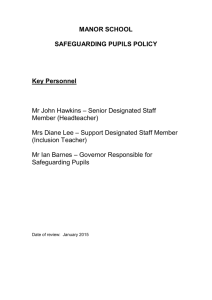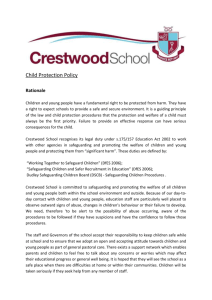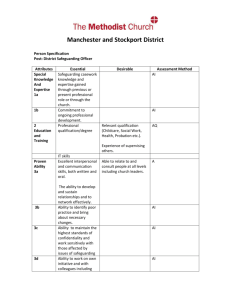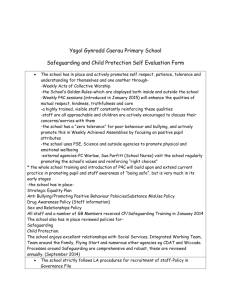School Policy for PSHE and Citizenship
advertisement
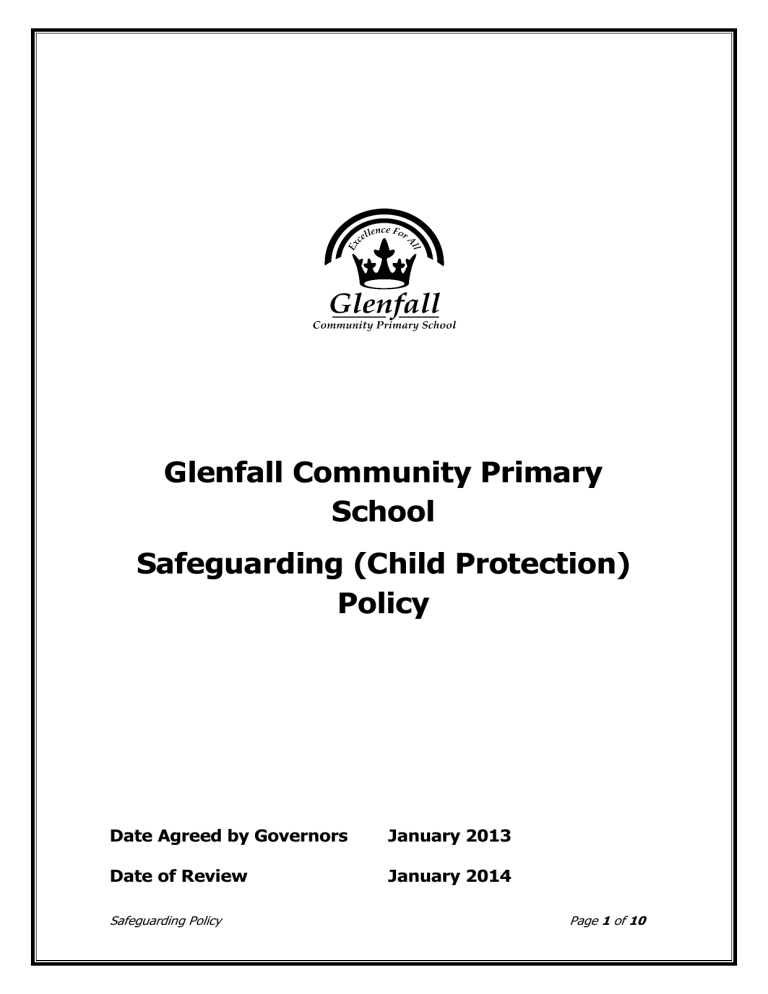
Glenfall Community Primary School Safeguarding (Child Protection) Policy Date Agreed by Governors January 2013 Date of Review January 2014 Safeguarding Policy Page 1 of 10 Safeguarding (Child Protection) Policy Key Staff Designated Child Protection Officer: Anthony Mitchell – Headteacher Deputy Designated Child Protection Officer: Mandy Newdeck Deputy Head Isobel Rutt Inclusion Coordinator Designated Child Protection Governor: Chantal Vermenitch Governor Trained Safer Recruitment Staff: Anthony Mitchell Clive Hodges Lisa James – – - Headteacher Governor Governor Introduction Glenfall Primary School fully recognises its responsibilities for safeguarding children (child protection) This policy assumes staff to include: teachers, TA’s, support staff, governors, volunteers and parent helpers working in the school. The health, safety and well-being of all our children are of paramount importance to all the adults who work in our school. Our children have the right to protection, regardless of age, gender, race, culture or disability. They have a right to be safe in our school. In our school we respect our children. The atmosphere within our school is one that encourages all children to do their best. We provide opportunities that enable our children to take and make decisions for themselves. Our teaching of personal, social and health education and citizenship, as part of the National Curriculum, helps to develop appropriate attitudes in our children and makes them aware of the impact of their decisions on others. We also teach them how to recognise different risks in different situations, and how to behave in response to them. Safeguarding Policy Page 2 of 10 Aims and Objectives This policy ensures that all staff in our school are clear about the actions and responsibilities connected with effective child protection. Its aims are: to raise the awareness of all staff and identify responsibility in reporting possible cases of abuse; to ensure effective communication between all staff when dealing with child protection issues; to lay down the correct procedures for those who encounter an issue of child protection. to ensure we practise safe recruitment in line with Government guidance by using at least one NCSL accredited recruiter on all interview panels. to check the suitability of staff and volunteers to work with children. to ensure any unsuitable behaviour is reported and managed using the Allegations Management procedures. (see appendix 2) to raise awareness of child protection issues and equipping children with the skills needed to keep them safe. To develop and implement procedures for identifying and reporting cases, or suspected cases, of abuse by logging welfare concerns and referring to the Children’s Helpdesk. (Appendices 1,3,4) to support pupils who have been abused in accordance with his/her agreed child protection plan. to establish a safe environment in which children can learn and develop. to ensure that children are protected against child protection issues related to internet safety. (see ICT policy) Procedures At Glenfall School, the head teacher is the ‘Designated Child Protection Officer’ If any member of staff or other adult suspects that a child may be a victim of abuse, they immediately inform the ‘Designated Child Protection Officer’ In the absence of the head teacher the report must be made to the Deputy Designated Child Protection Officer who is also trained in child protection issues. In the absence of the Designated Child Protection Officer or Deputy Designated Child Protection Officer individuals should follow the procedure laid out in appendix 1. Following a report of abuse the designated officer will follow the local procedure for safeguarding children.(see appendix 1 Safeguarding Policy Page 3 of 10 We require all adults employed in school to have their application vetted through the CRB in order to ensure that there is no evidence of offences involving children or abuse. There may be times when adults in our school, in the course of their duty, use physical intervention to restrain children. The headteacher requires the adult involved in any such incident to report this to them immediately. All adults in the school receive regular training to raise their awareness of abuse and their knowledge of agreed local child protection procedures. For the designated officers this is every 2 years and all other staff every 3 years. We recognise that because of the day to day contact with children, school staff are well placed to observe the outward signs of abuse. The school will therefore: establish and maintain an environment where children feel secure, are encouraged to talk, and are listened to. ensure children know that there are adults in the school whom they can approach if they are worried. include opportunities in the PSHE curriculum for children to develop the skills they need to recognise and stay safe from abuse. We will follow the procedures set out by the Gloucestershire Safeguarding Children Board and take account of guidance issued by the Department for Children, Schools and Families to: ensure we have a designated senior person for safeguarding (child protection) who has received appropriate training and support for this role. ensure we have a nominated governor responsible for child protection who has received appropriate training. ensure every member of staff (including temporary and supply staff and volunteers) and governing body knows the name of the designated senior person responsible for child protection and their role. ensure all staff and volunteers understand their responsibilities in being alert to the signs of abuse and responsibility for referring any concerns to the designated senior person responsible for child protection. ensure that parents have an understanding of the responsibility placed on the school and staff for child protection by setting out its obligations in the school prospectus. notify the relevant social worker if there is an unexplained absence of more than two days of a pupil who has a Child protection Plan (previously known as being on the child protection register.) Safeguarding Policy Page 4 of 10 develop effective links with relevant agencies and co-operate as required with their enquiries regarding child protection matters including attendance at child protection conferences and core groups. keep written records of concerns about children, even where there is no need to refer the matter immediately. ensure all records are kept securely, separate from the main pupil file, and in locked locations. follow procedures where an allegation or complaint (see appendix 2) is made against a member of staff or volunteer including supply or agency workers, contractors or governors and regularly monitor and update each year. We recognise that children who are abused or witness violence may find it difficult to develop a sense of self worth. They may feel helplessness, humiliation and some sense of blame. The school may be the only stable, secure and predictable element in the lives of children at risk. When at school their behaviour may be challenging and defiant or they may be withdrawn. The school will endeavour to support the pupil through: the content of the curriculum. the school ethos which promotes a positive, supportive and secure environment and gives pupils a sense of being valued. the school behaviour policy which is aimed at supporting vulnerable pupils in the school. The school will ensure that the pupil knows that some behaviour is unacceptable but they are valued and not to be blamed for any abuse which has occurred. liaison with other agencies that support the pupil such as social care, Child and Adult Mental Health Service, education welfare service and educational psychology service. ensuring that, where a pupil who has a child protection plan leaves, their information is transferred to the new school immediately and that the child's social worker is informed. Monitoring and review The governing body is kept informed of any child protection issues through the Heads report to governors. A named governor participates in the school’s training with regard to the child protection procedures and a trained recruiter sits on the interview panel for any appointment to the school staff. Safeguarding Policy Page 5 of 10 Appendix 1 - Referal Procedure Professional has concerns If a Professional has a concern about the well being of a child (or unborn baby), then that professional should:Consultation with supervisor share their concerns with their supervisor/line manager/designated teacher or named professional to help clarify the nature of their concerns Completion of written record complete a written record of the nature and circumstances surrounding the concern including any previous concerns held Contact social workers for advice in those cases where you have a concern but are unsure about how to proceed contact the Children’s Help Desk Tel: 01452 426 565 and ask to speak to a social work practitioner . Contact the children’s helpdesk In those cases where you are clear a social work assessment is required make a referral to the: Children’s Help Desk Tel: 01452 426 565 injury or within 24 hours (immediately if the concerns are about physical sexual abuse). The CYPD social care section will then take responsibility for managing any subsequent enquiries. The referrer should confirm the details of the concern to CYPD, in writing, within 48 hours Resolving professional Difference (escalation policy) Remember to use the „resolution of professional difficulties (escalation) procedures if you are left feeling that the response from social care has not addressed your concerns for the child. Advice about procedural issues including using the resolving professional differences procedures can be obtained through the Safeguarding Children Service on 01452 58 3629 For out of hours social work advice please contact the Emergency Duty Team on 01452 614 194 Safeguarding Policy Page 6 of 10 Appendix 2 – Summary of allegations management procedures Concern about a member of staff or volunteer working with children If a Professional receives an allegation or has a concern about the behaviour of a member of staff working or volunteering with children and that concern could amount to: a. a member of staff or volunteer has behaved in a way that has harmed a child, or may have harmed a child; or b. possibly committed a criminal offence against or related to a child; or c. behaved towards a child or children in a way that indicates s/he is unsuitable to work with children. then that professional should:Report their concerns Report the concern to the most senior person not implicated in the allegation. Completion of written record Complete a written record of the nature and circumstances surrounding the concern including any previous concerns held. Include where the concern came from and brief details only. Seek advice before proceeding – Initial Discussion Always contact the Local Authority Designated Officer for Allegations (LADO) for advice prior to investigating the allegation. This is because it might meet the criminal threshold and so your investigation could interfere with a police or Social Care investigation. Local Authority Designated officer (LADO) Tel: 01452 426 994 The LADO will offer advice on any immediate action required and will assist with employment and safeguarding issues. Allegations Management Process Safeguarding Policy Page 7 of 10 If, after your Initial Discussion with the LADO, its agreed that the allegation meets the criteria, a multi agency meeting will be convened and you will be invited. This might result in a criminal investigation, a Social Care investigation or and/or an investigation to inform whether disciplinary action is required. If its agreed that the allegation does not meet the criteria, the LADO will record the Initial Discussion and send it to you for your records. Any further action will be taken within your setting if necessary. Further action Further meetings might be required and these will be convened by the LADO with your input at all times. Further information on the Allegations Management process can be found at Appendix 5 of the Government Document Working Together to Safeguard Children (2010). https://www.education.gov.uk/publications/standard/publi cationDetail/Page1/DCSF-00305-2010 Appendix 3 – Signs and Symptoms This is intended as a guide. Please remember that the presence of one or more factors does not necessarily give proof that child abuse has occurred. It may, however, indicate that investigation should take place. Unexplained delay in seeking treatment which is needed Incompatible explanations Constant minor injuries Unexplained bruising: – Bruise marks in or around the mouth – Black eyes, especially if both eyes are black and there are no marks to forehead or nose – Grasp marks – Finger marks – Bruising of the ears – Linear bruising (particularly buttocks or back) – Differing age bruising Bite marks Safeguarding Policy Page 8 of 10 Burns and scalds Cigarette burns General physical disability Unresponsiveness in the child Soiling and wetting Change in behavioural patterns ‘Frozen’ look Attention seeking Apprehension Antisocial behaviour Unkempt appearance Sexually precocious behaviour Sexualised drawings and play Sudden poor performance in school Poor self-esteem Self-mutilation Withdrawal Running away Reluctance to return home after school Resistance to PE (undressing) Resistance to school medicals Difficulty in forming relationships Confusing affectionate displays Poor attendance – repeated infections etc. Safeguarding Policy Page 9 of 10 Appendix 4 – Definitions of Child Abuse An abused child is a boy or girl under the age of 17 who has suffered from physical injury, physical neglect, failure to thrive, emotional or sexual abuse, which the person who has had custody, charge or care of the child either caused or knowingly failed to prevent. Having custody, charge or care includes any person, in whatever setting, who, at the time, is responsible for that child. Physical Abuse Physical injury to a child, including deliberate poisoning, where there is definite knowledge, or a reasonable suspicion that the injury was inflicted or knowingly not prevented. Sexual Abuse The involvement of dependent, developmentally immature children and adolescents in sexual activities that they do not truly comprehend, and to which they are unable to give informed consent; or they violate the social taboos of family roles. Neglect The persistent or severe neglect of a child (for example by exposure to any kind of danger including cold or starvation) which results in serious impairment of the child’s health or development, including non-organic failure to thrive. Emotional Abuse The severe adverse effect on the behaviour and emotional development of a child by persistent or severe emotional illtreatment or rejection. All abuse involves some emotional illtreatment; this category should be used where it is the main or sole form of abuse. Safeguarding Policy Page 10 of 10
